Hello everyone..
I’ve only just started this hobby, as my main one was actually WWII history/firearms and only recently have been turned on to earlier history.
Anyway, I was wondering about the Rus. Being Northern Germanic and Eastern European in descent I have started an interest in them (I had always had an interest in the Vikings - Being a large, bearded man its kinda a given). If someone could point me in a direction for their history and what they generally wore that would be greatly appreciated. Also any other of info on them would be great, books would be awesome as well.
I had originally wanted to start with a Viking kit as its fairly common (I have a small budget) but something about the small amount on the Rus I’ve read has caught my interest.
If anyone has some links for places that sell equipment I could use that would be great (Ive already got a sword though :D )
Sorry for being a n00b. hahaha.
Thank you. – If this is the wrong place to post this I apologize
Kris Kuznak
I have moved this topic to the Off-topic Talk forum.
Please note the description for the historic arms talk forum is: "Discussions of reproduction and authentic historical arms and armour from various cultures and time periods"
This is more of a general conversation about the people and their "stuff" than about specific "stuff" so it's better off here :)
Thank you.
Please note the description for the historic arms talk forum is: "Discussions of reproduction and authentic historical arms and armour from various cultures and time periods"
This is more of a general conversation about the people and their "stuff" than about specific "stuff" so it's better off here :)
Thank you.
| K W Kuznak wrote: |
| Hello everyone..
I’ve only just started this hobby, as my main one was actually WWII history/firearms and only recently have been turned on to earlier history. Anyway, I was wondering about the Rus. Being Northern Germanic and Eastern European in descent I have started an interest in them (I had always had an interest in the Vikings - Being a large, bearded man its kinda a given). If someone could point me in a direction for their history and what they generally wore that would be greatly appreciated. Also any other of info on them would be great, books would be awesome as well. I had originally wanted to start with a Viking kit as its fairly common (I have a small budget) but something about the small amount on the Rus I’ve read has caught my interest. If anyone has some links for places that sell equipment I could use that would be great (Ive already got a sword though :D ) Sorry for being a n00b. hahaha. Thank you. – If this is the wrong place to post this I apologize Kris Kuznak |
As a starting point i would suggest 3 Men-at-Arms titles, click on the links please:
http://www.myArmoury.com/books/item.php?ASIN=1855328488
http://www.myArmoury.com/books/item.php?ASIN=1841762342
http://www.myArmoury.com/books/item.php?ASIN=1841769258
After that the search gets harder, most books about the Medieval Rus are out of print and not in English.
I leave you with this:







The first helmet is 12th century, the rest of the armour and weapons is 16th-17th century.
| Nathan Robinson wrote: |
| I have moved this topic to the Off-topic Talk forum.
Please note the description for the historic arms talk forum is: "Discussions of reproduction and authentic historical arms and armour from various cultures and time periods" This is more of a general conversation about the people and their "stuff" than about specific "stuff" so it's better off here :) Thank you. |
heh, thank you. I had a feeling that I might have posted it in the wrong place. ahh well. Better luck next time. :)
thank you for the links to the books Ill have to check them out. And I appreciate the images.
| K W Kuznak wrote: |
| thank you for the links to the books Ill have to check them out. And I appreciate the images. |
Let me echo that. This is a subject that is becoming increasingly interesting to me!
Hi
What period? 8-10thc 0r later, because there is a big differance in equipment. Another thing to remember is alot of equipment that people claim are Rus items usually arent. Most sabres, helmets ,armours, plaque belts are either Khazar /Magyar examples and later Kipchack /pechenneg. The Rus grew very fond of the steppe peoples military equipment as can be seen by the amount of nomadic influence in Birka male and female graves.
This is a typical picture of Rus (very rich) equipment. Not one piece is of viking rus make.
The sabre is the Gorochevo sabre - thought to be of saltov culture make.
Helmet is from Gnezdovo, this helmet and the great Polish serious helmets are thought to be made in kabarian/khazar workshops.
Belt is from Gnezdovo also, small bear plaques.
The caftan mounts are also from the Gnezdovo burial. The palmete decoration on the plaques is typical of early magyar conquest art.
The burial itself was a cremation so the caftan design in this pic is conjectural. Alanic kaftans have survived and are of similiar cut.
This equipment is from the 9th-10th c.
Any more Q,s I would be happy to help.
Nick
 Attachment: 44.95 KB
Attachment: 44.95 KB
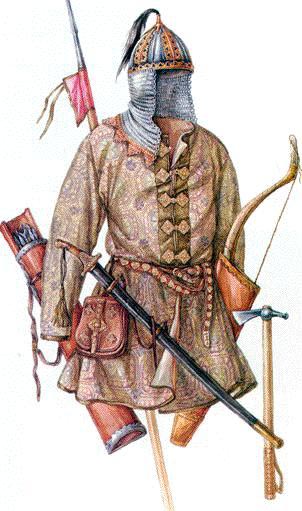
What period? 8-10thc 0r later, because there is a big differance in equipment. Another thing to remember is alot of equipment that people claim are Rus items usually arent. Most sabres, helmets ,armours, plaque belts are either Khazar /Magyar examples and later Kipchack /pechenneg. The Rus grew very fond of the steppe peoples military equipment as can be seen by the amount of nomadic influence in Birka male and female graves.
This is a typical picture of Rus (very rich) equipment. Not one piece is of viking rus make.
The sabre is the Gorochevo sabre - thought to be of saltov culture make.
Helmet is from Gnezdovo, this helmet and the great Polish serious helmets are thought to be made in kabarian/khazar workshops.
Belt is from Gnezdovo also, small bear plaques.
The caftan mounts are also from the Gnezdovo burial. The palmete decoration on the plaques is typical of early magyar conquest art.
The burial itself was a cremation so the caftan design in this pic is conjectural. Alanic kaftans have survived and are of similiar cut.
This equipment is from the 9th-10th c.
Any more Q,s I would be happy to help.
Nick

A more typical picture of the Rus warior. Well armoured infantryman. The sword, round shield are of viking taste ( though round shields are popular with steppe peoples also). The information on this pic escapes me at the moment.
There are not many good books on rus, nomadic peoples out there but the ones available are great.
The Ancient Hungarians
Companion to Medieval Arms and Armour ( A whole chapter on Khazars and Magayars YAY)
Europas Mitte Um, in german but very good, many western and eastern tid bits from the 10th c.
Arms and Armour of the crusading era, eastern. Not bad.
Arms and Armour of Medieval Russia, Kirpitchnikov.
Cheers
Nick
 Attachment: 71.28 KB
Attachment: 71.28 KB
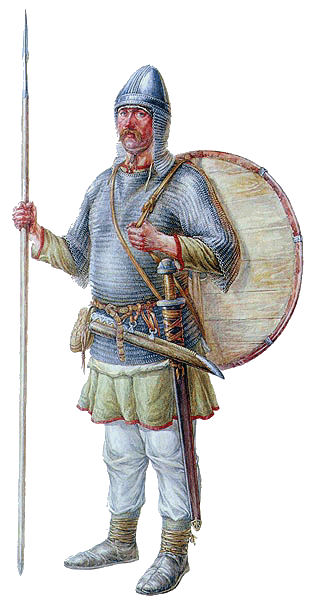
There are not many good books on rus, nomadic peoples out there but the ones available are great.
The Ancient Hungarians
Companion to Medieval Arms and Armour ( A whole chapter on Khazars and Magayars YAY)
Europas Mitte Um, in german but very good, many western and eastern tid bits from the 10th c.
Arms and Armour of the crusading era, eastern. Not bad.
Arms and Armour of Medieval Russia, Kirpitchnikov.
Cheers
Nick

May I also add that in addition to the differences across time, there were also regional differences between the 2 most powerful medieval Rus principalities, Novgorod and Muscovy. AFAIK Rus arms and armour prior to about 1300 AD showed a mixture of Steppe, Byzantine and (old-fashioned) Western European influences.
Novgorodian arms and armour retained the "Western" influence right into the 15th century, where as 15th century Muscovite equipment was almost entirely "Turco-Persian" in appearence.
I think the first thing you decide is where and what period is your Rus warrior from.
Novgorodian arms and armour retained the "Western" influence right into the 15th century, where as 15th century Muscovite equipment was almost entirely "Turco-Persian" in appearence.
I think the first thing you decide is where and what period is your Rus warrior from.
You know,
regardless of the country of manufacture. I love that sword on the lower left. Sharp, curvy and pointy :D :D . Does anyone have any other pictures?
Cheers,
regardless of the country of manufacture. I love that sword on the lower left. Sharp, curvy and pointy :D :D . Does anyone have any other pictures?
Cheers,
haha, how stupid of me not to give a time period.. I was looking for anything 9th - 11thC
Lots of great images and info! Thanks!
Lots of great images and info! Thanks!
| K W Kuznak wrote: |
| haha, how stupid of me not to give a time period.. I was looking for anything 9th - 11thC
Lots of great images and info! Thanks! |
In that case we are talking about 'Kievan Rus'. Not a lot survives from this period. AFAIK Rus equipment from this period would have shown a mixture of Central Asian, Byzantine and Scandinavian influences.
Era is more important than anything. With the 'Mongol' (it was predominately Tatar) invasion you get an increasing abundance of Turco-Mongolic/Persian equipment. I would strongly advise against examining the images of the Osprey book 'Medieval Russian Armies 1250-1500' too closely, as they stress overmuch on the lamellar type armour, whereas if you look at any archaeological (and, yes, pictorial) evidence from that era you'll find few representations of such armour from that era, but far, far more often you'll find maille and, curiously, scale-type armours, which were prevalent throughout medieval Russia.
You'll also find early types of Bakhteretz (the armour that Hisham shows) which were extremely popular in the 16th and even 17th centuries in places such as the Kulikovo Museum. Personally, I absolutely adore maille-and-plates armours.
You'll find two main types of helmet in the later period. The extremely antiquated Viking-style helmets, with nasal and all, and a newer type which looked a lot like a funnel stuck on top of a can, and has some Turco-Persian parallels. There were also various bascinets, though they were few and far between, and would have come from the Crimea where the Genoese hung about or from Novgorodian involvement in the Hanseatic league.
Thanks to its Western association, there is also some archaeological evidence of coat-of-plates or brigandine-type armours in Novgorod.
I'm working on an early 15th c. Muscovite kit (1417, specifically), so I've been thinking about Russian arms & armour in great detail. There is a fair deal of evidence to suggest that western arms and armour survived in decent quantity in Muscovy until the mid 16th century, at which point it was subsumed by Eastern influence.
Axes have always been popular weapons in Russia, and continue to be today. In the later centuries you get a type called a Berdysh or Bardiche, which is generally two-handed and has a unique shape. There's a decent illustration of one in the Osprey book mentioned above, and a thread on them here
Sword evolution followed patterns that were much closer to the Western types than armour did. Of course, you also have a huge number of sabers in Eastern principalities like Muscovy.
What might also interest you is Polo-Lithuanian arms and armour. Since Lithuania, during the late 14th century, controlled Kiev, and indeed was one of the largest nations in Europe (it had subsumed Poland in a marital alliance) it had a good mixture of up-to-date Western Arms & Armours as well as some Eastern-influenced equipment.
I will give three big generalizations, though:
1. Shields were more popular in late-medieval Russia than in the late-medieval West.
2. Outside of Novgorod (which had a well-trained and well-equipped militia) you will predominantly find cavalry in the post-Mongol period.
3. The Russian principalities preferred aventails to coifs.
So, in considering Russian Arms & Armour, one must take into account a few things.
First: Which Russian principality is being considered? Kiev? Pskov? Muscovy? Novgorod? Galicia-Volhynia? Lithuania, even?
Second: What era is being considered? The time of St. Aleksandr Nevsky? St. Vladimir the Great? Dmitrii Donskoi? Ivan the Great?
Third: For whom is the weapon or armour meant? A rich Boyar or Druzhina? A member of a militia? A musketeer or Streltsy?
Unfortunately, the best sources on Russian Arms and Armour are in the vernacular or museums, but David Nicolle wrote a decent pair of books called 'Arms and Armour of the Crusading Era'. One of these two books focuses on Russia, Asia, and North Africa and Ethiopia, the other on mainland Europe. It's basically a load of archaeological information taken mostly out of context, but it allows the imagination to run wild, as a lot of the information is fragments of armour.
For earlier arms & armour, look at the Osprey book, and also consider Companion to medieval Arms and Armour, which has an article by Michael Gorelik on early Khazar, Magyar, and Rus' arms and armour.
An earlier thread on Russian armour might also interest you. http://www.myArmoury.com/talk/viewtopic.php?t=5069
You'll also find early types of Bakhteretz (the armour that Hisham shows) which were extremely popular in the 16th and even 17th centuries in places such as the Kulikovo Museum. Personally, I absolutely adore maille-and-plates armours.
You'll find two main types of helmet in the later period. The extremely antiquated Viking-style helmets, with nasal and all, and a newer type which looked a lot like a funnel stuck on top of a can, and has some Turco-Persian parallels. There were also various bascinets, though they were few and far between, and would have come from the Crimea where the Genoese hung about or from Novgorodian involvement in the Hanseatic league.
Thanks to its Western association, there is also some archaeological evidence of coat-of-plates or brigandine-type armours in Novgorod.
I'm working on an early 15th c. Muscovite kit (1417, specifically), so I've been thinking about Russian arms & armour in great detail. There is a fair deal of evidence to suggest that western arms and armour survived in decent quantity in Muscovy until the mid 16th century, at which point it was subsumed by Eastern influence.
Axes have always been popular weapons in Russia, and continue to be today. In the later centuries you get a type called a Berdysh or Bardiche, which is generally two-handed and has a unique shape. There's a decent illustration of one in the Osprey book mentioned above, and a thread on them here
Sword evolution followed patterns that were much closer to the Western types than armour did. Of course, you also have a huge number of sabers in Eastern principalities like Muscovy.
What might also interest you is Polo-Lithuanian arms and armour. Since Lithuania, during the late 14th century, controlled Kiev, and indeed was one of the largest nations in Europe (it had subsumed Poland in a marital alliance) it had a good mixture of up-to-date Western Arms & Armours as well as some Eastern-influenced equipment.
I will give three big generalizations, though:
1. Shields were more popular in late-medieval Russia than in the late-medieval West.
2. Outside of Novgorod (which had a well-trained and well-equipped militia) you will predominantly find cavalry in the post-Mongol period.
3. The Russian principalities preferred aventails to coifs.
So, in considering Russian Arms & Armour, one must take into account a few things.
First: Which Russian principality is being considered? Kiev? Pskov? Muscovy? Novgorod? Galicia-Volhynia? Lithuania, even?
Second: What era is being considered? The time of St. Aleksandr Nevsky? St. Vladimir the Great? Dmitrii Donskoi? Ivan the Great?
Third: For whom is the weapon or armour meant? A rich Boyar or Druzhina? A member of a militia? A musketeer or Streltsy?
Unfortunately, the best sources on Russian Arms and Armour are in the vernacular or museums, but David Nicolle wrote a decent pair of books called 'Arms and Armour of the Crusading Era'. One of these two books focuses on Russia, Asia, and North Africa and Ethiopia, the other on mainland Europe. It's basically a load of archaeological information taken mostly out of context, but it allows the imagination to run wild, as a lot of the information is fragments of armour.
For earlier arms & armour, look at the Osprey book, and also consider Companion to medieval Arms and Armour, which has an article by Michael Gorelik on early Khazar, Magyar, and Rus' arms and armour.
An earlier thread on Russian armour might also interest you. http://www.myArmoury.com/talk/viewtopic.php?t=5069
Last edited by Alexander Hinman on Tue 05 Dec, 2006 4:33 am; edited 1 time in total
Hi
9-11th c is not a bad period to do, you have 3 avenues. You can keep your kit distinctly viking in taste ( swedish ) or you can move more towards a eastern kit, or do a varangian in Byzantine service ( with distinct Byz taste). Doing Rus during this period is a open door, there are so many possibilities. I myself love the art ,arms and armour of the Magyars and khazars, and it is plain to see the effect it had on the Rus during the period you propose to do.
Have fun, scratch the surface and you will see there is soooo much info.
Nick
9-11th c is not a bad period to do, you have 3 avenues. You can keep your kit distinctly viking in taste ( swedish ) or you can move more towards a eastern kit, or do a varangian in Byzantine service ( with distinct Byz taste). Doing Rus during this period is a open door, there are so many possibilities. I myself love the art ,arms and armour of the Magyars and khazars, and it is plain to see the effect it had on the Rus during the period you propose to do.
Have fun, scratch the surface and you will see there is soooo much info.
Nick
Byzantine officer 10-11 c
sorry about that here is the pic
 Attachment: 81.85 KB
Attachment: 81.85 KB
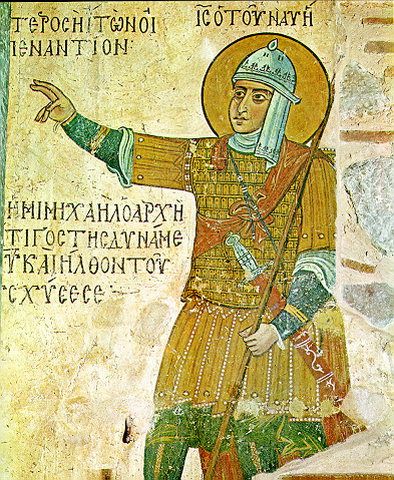

This is my friend Pete, he has copied a full male costume from one of the Birka male graves.
very good, and very accurate.
 Attachment: 84.76 KB
Attachment: 84.76 KB
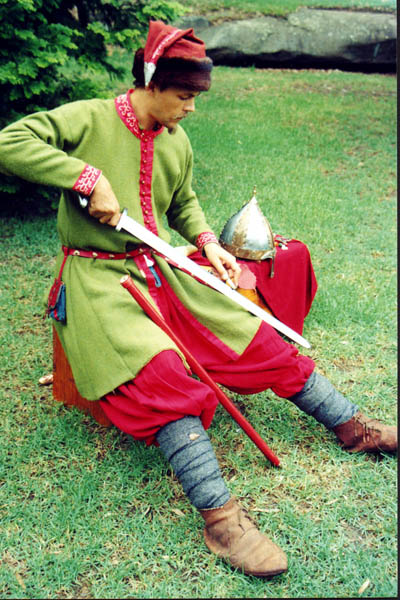
very good, and very accurate.

A khazar warrior,
 Attachment: 33.31 KB
Attachment: 33.31 KB
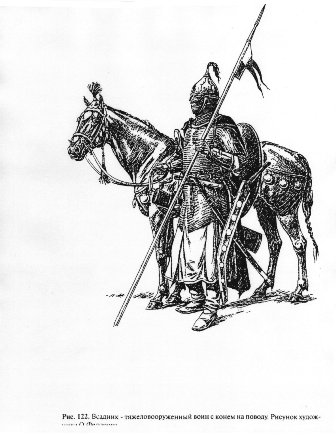

I to share your fascination for the Rus. I am a member of a Swedish reenactment group called Upsala Rus which focus on eastern influenced Viking culture.
Like Mr. Trueman already pointed out there is a lot of finds from Swedish Birka.
The most popular idea is that the name RUS is related to the Swedish area around lake Mälaren called Roslagen (the Ros law). Another theory is that the name is related to the Finnish name for Sweden Ruotsi. Several historical writings mention the Rus as another name for svearna, the people living in area of Lake Mälaren.
Birka is situated in Lake Mälaren and archeological finds point to a very lively traffic to the east. There have been a lot of papers written recently, but unfortunately they are all in Swedish. Just like Mr. Trueman pointed out the graves show a significant amount of influences from the Magyars, especially when it comes to the bow culture.
Check out these sites:
http://www.historiska.se/histvarld/eng/drakte...errefr.htm
http://www.strangelove.net/~kieser/Russia/KRC.html
Like Mr. Trueman already pointed out there is a lot of finds from Swedish Birka.
The most popular idea is that the name RUS is related to the Swedish area around lake Mälaren called Roslagen (the Ros law). Another theory is that the name is related to the Finnish name for Sweden Ruotsi. Several historical writings mention the Rus as another name for svearna, the people living in area of Lake Mälaren.
Birka is situated in Lake Mälaren and archeological finds point to a very lively traffic to the east. There have been a lot of papers written recently, but unfortunately they are all in Swedish. Just like Mr. Trueman pointed out the graves show a significant amount of influences from the Magyars, especially when it comes to the bow culture.
Check out these sites:
http://www.historiska.se/histvarld/eng/drakte...errefr.htm
http://www.strangelove.net/~kieser/Russia/KRC.html
Hey guys
Heres some links for early russian stuff
http://www.hermitagemuseum.org/html_En/08/hm88_0_0_20_1.html (type in Alanic or caftan)
http://members.ozemail.com.au/~chrisandpeter/...elmets.htm
http://photofile.ru/users/bookworm/1303837/?page=1
http://www.tarsolyosok.hu/eng/Index.html
http://www.geocities.com/kaganate/
http://brand.io.com.ua/album6553_0
http://south-rus.narod.ru/manvelovka.html
Heres some links for early russian stuff
http://www.hermitagemuseum.org/html_En/08/hm88_0_0_20_1.html (type in Alanic or caftan)
http://members.ozemail.com.au/~chrisandpeter/...elmets.htm
http://photofile.ru/users/bookworm/1303837/?page=1
http://www.tarsolyosok.hu/eng/Index.html
http://www.geocities.com/kaganate/
http://brand.io.com.ua/album6553_0
http://south-rus.narod.ru/manvelovka.html
And a personal favorite - Tgorod on google images.
Alot of that armour is early khazar/alanic. ( of coarse not the vendal stuf)
http://images.google.com.au/images?hl=en&...rch+Images
Alot of that armour is early khazar/alanic. ( of coarse not the vendal stuf)
http://images.google.com.au/images?hl=en&...rch+Images
Page 1 of 2
You cannot post new topics in this forumYou cannot reply to topics in this forum
You cannot edit your posts in this forum
You cannot delete your posts in this forum
You cannot vote in polls in this forum
You cannot attach files in this forum
You can download files in this forum
All contents © Copyright 2003-2006 myArmoury.com — All rights reserved
Discussion forums powered by phpBB © The phpBB Group
Switch to the Full-featured Version of the forum
Discussion forums powered by phpBB © The phpBB Group
Switch to the Full-featured Version of the forum